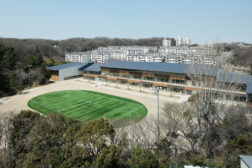Articles by Lamar Anderson
Activist Design
In a time of growing humanitarian crisis, climate change, and mounting income inequality, socially engaged architects and the groups they have organized are no longer relegated to the field's fringes.
Read More
Topo House
A hill-hugging landform of a structure that rises like a zigzagging ramp out of a grassy incline.
Read More
Market Square
Urban Game Changer: Having attracted Twitter, upscale retail, and a food emporium as key tenants, a renovated Art Deco building is kick-starting the transformation of a once-seedy part of San Francisco.
Read More
North Atlanta High School
Open for Business: A visionary plan transforms a former IBM office complex into a high school that’s anything but textbook.
Read More
Copyright ©2025. All Rights Reserved BNP Media.
Design, CMS, Hosting & Web Development :: ePublishing
